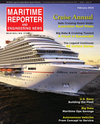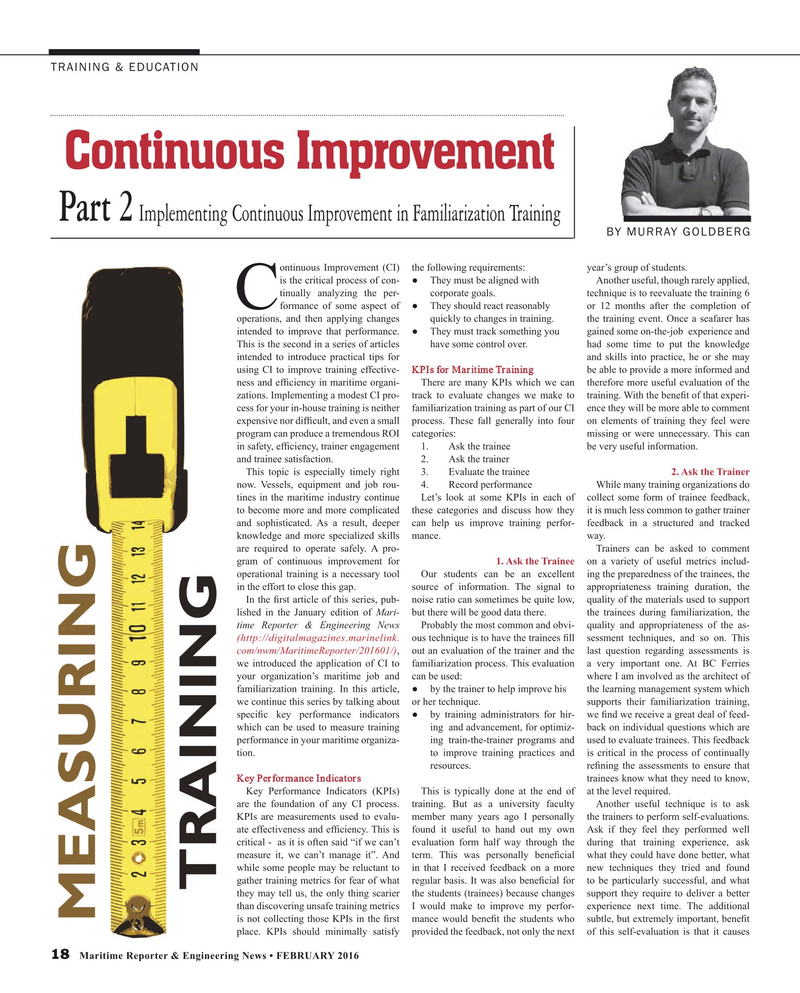
Page 18: of Maritime Reporter Magazine (February 2016)
Cruise Ship Technology Edition
Read this page in Pdf, Flash or Html5 edition of February 2016 Maritime Reporter Magazine
TRAINING & EDUCATION
Continuous Improvement
Part 2 Implementing Continuous Improvement in Familiarization Training
BY MURRAY GOLDBERG ontinuous Improvement (CI) the following requirements: year’s group of students. is the critical process of con- ? They must be aligned with Another useful, though rarely applied, tinually analyzing the per- corporate goals. technique is to reevaluate the training 6
Cformance of some aspect of ? They should react reasonably or 12 months after the completion of operations, and then applying changes quickly to changes in training. the training event. Once a seafarer has intended to improve that performance. ? They must track something you gained some on-the-job experience and
This is the second in a series of articles have some control over. had some time to put the knowledge intended to introduce practical tips for and skills into practice, he or she may using CI to improve training effective- KPIs for Maritime Training be able to provide a more informed and ness and ef? ciency in maritime organi- There are many KPIs which we can therefore more useful evaluation of the zations. Implementing a modest CI pro- track to evaluate changes we make to training. With the bene? t of that experi- cess for your in-house training is neither familiarization training as part of our CI ence they will be more able to comment expensive nor dif? cult, and even a small process. These fall generally into four on elements of training they feel were program can produce a tremendous ROI categories: missing or were unnecessary. This can in safety, ef? ciency, trainer engagement 1. Ask the trainee be very useful information. and trainee satisfaction. 2. Ask the trainer
This topic is especially timely right 3. Evaluate the trainee 2. Ask the Trainer now. Vessels, equipment and job rou- 4. Record performance While many training organizations do tines in the maritime industry continue Let’s look at some KPIs in each of collect some form of trainee feedback, to become more and more complicated these categories and discuss how they it is much less common to gather trainer and sophisticated. As a result, deeper can help us improve training perfor- feedback in a structured and tracked knowledge and more specialized skills mance. way.
are required to operate safely. A pro- Trainers can be asked to comment gram of continuous improvement for 1. Ask the Trainee on a variety of useful metrics includ- operational training is a necessary tool Our students can be an excellent ing the preparedness of the trainees, the in the effort to close this gap. source of information. The signal to appropriateness training duration, the
In the ? rst article of this series, pub- noise ratio can sometimes be quite low, quality of the materials used to support lished in the January edition of Mari- but there will be good data there. the trainees during familiarization, the time Reporter & Engineering News Probably the most common and obvi- quality and appropriateness of the as- (http://digitalmagazines.marinelink. ous technique is to have the trainees ? ll sessment techniques, and so on. This com/nwm/MaritimeReporter/201601/), out an evaluation of the trainer and the last question regarding assessments is we introduced the application of CI to familiarization process. This evaluation a very important one. At BC Ferries your organization’s maritime job and can be used: where I am involved as the architect of familiarization training. In this article, ? by the trainer to help improve his the learning management system which we continue this series by talking about or her technique. supports their familiarization training, speci? c key performance indicators ? by training administrators for hir- we ? nd we receive a great deal of feed- which can be used to measure training ing and advancement, for optimiz- back on individual questions which are performance in your maritime organiza- ing train-the-trainer programs and used to evaluate trainees. This feedback tion. to improve training practices and is critical in the process of continually resources. re? ning the assessments to ensure that
Key Performance Indicators trainees know what they need to know,
Key Performance Indicators (KPIs) This is typically done at the end of at the level required.
are the foundation of any CI process. training. But as a university faculty Another useful technique is to ask
KPIs are measurements used to evalu- member many years ago I personally the trainers to perform self-evaluations. ate effectiveness and ef? ciency. This is found it useful to hand out my own Ask if they feel they performed well critical - as it is often said “if we can’t evaluation form half way through the during that training experience, ask measure it, we can’t manage it”. And term. This was personally bene? cial what they could have done better, what while some people may be reluctant to in that I received feedback on a more new techniques they tried and found gather training metrics for fear of what regular basis. It was also bene? cial for to be particularly successful, and what they may tell us, the only thing scarier the students (trainees) because changes support they require to deliver a better than discovering unsafe training metrics I would make to improve my perfor- experience next time. The additional is not collecting those KPIs in the ? rst mance would bene? t the students who subtle, but extremely important, bene? t place. KPIs should minimally satisfy provided the feedback, not only the next of this self-evaluation is that it causes 18 Maritime Reporter & Engineering News • FEBRUARY 2016
MR #2 (18-25).indd 18 2/3/2016 10:21:23 AM

 17
17

 19
19
